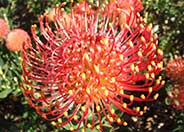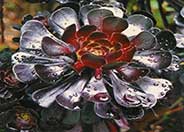
Common name:Peppermint Tree
Botanical name:Agonis flexuosa
Peppermint Tree (Agonis flexuosa) is an excellent specimen tree for small- and medium-sized gardens. This Australian native tree reaches 35' tall and 15’-30’ wide, is very low-water-use, and is low maintenance. These trees can be found in nurseries in both single-trunk and multi-trunk forms. The natural growth habit is weeping and irregular, so it does require some selective pruning and shaping when it is young to achieve the desired look. Thinning out the heavy, weeping branches will take some of the weight out of them, and they usually lift. The tree may require this type of pruning a few times a year for the first two or three years. Once it has reached a height requiring a ladder to prune, it should be shaped by a licensed arborist. Since this tree has very low water use, it is susceptible to root rot during the hotter months if it is overwatered. It does very well in California-friendly gardens that typically prefer most of their irrigation in the fall, winter, and spring, with very little supplemental water in the summer. This tree should be planted at least five feet away from any hardscape areas, 10 feet from structures such as houses and buildings, and not near any powerlines. Shrubs and perennials should be planted about three feet away from this tree. It should be irrigated for about 45 minutes once a week when using most in-line drip irrigation systems.

Common name:Sea Lavender, Statice
Botanical name:Limonium perezii
This mounding shrub will reach about 3' high and has large, dark green leaves with small blue and purple flowers that bloom in spring and summer.

Common name:Blue Fescue
Botanical name:Festuca glauca
This ground cover/grass will grow less than 1' tall and has small, blue green leaves.
Maintenance Tips
Festuca glauca is a perennial clump-forming grass. It has soft straw-like leaves that form a blue-green dome that can get up to about 10 inches wide and tall. They prefer full sun and well-drained soil, but can tolerate slight shade, drought conditions, and poor soil nutrition. These will send out flower stalks in the summer, which should be cut back to the base after a few months to give them a cleaner appearance. They will also benefit from having any dead leaves pulled from the plant at any time of year, but the fall is typically the best time to clean up the foliage. It is short-lived in the landscape, with a lifespan of about 2-4 years after which it dies out in the center. Some might dig up and divide the living edges into several new plants, but most of the time it is easier to replace with a new one.
Common name:California Gray Rush
Botanical name:Juncus patens
Although a wetland plant, Juncus patens can tolerate fairly dry conditions. It will slowly clump to 2'-3' wide and a height of 2'-2.5'. There are many selections of this species available with different heights and widths. It is carefree, with little to no maintenance. It provides great upright structure to many styles of landscapes.

Common name:Marina Strawberry Madrone
Botanical name:Arbutus 'Marina'
Marina Strawberry Tree (Arbutus marina) is a small-to-medium evergreen tree that is one of the most popular specimen trees for Southern California gardens. It matures at 40’ tall and 30’ wide and is easily kept in the 15’ range with regular pruning. It has a deep red bark and deep green foliage that resembles a Manzanita. This tree is appropriate in almost any garden setting with almost any soil or moisture level. When it is young, it grows quickly, so it benefits greatly from some selective pruning. The natural growth habit is more shrub-like, especially in the multi-trunk form, so removing some of the lower new branches and exposing the trunk will improve the look and shape. Once the tree canopy is out of reach, a licensed arborist should maintain the tree to keep its natural shape. This tree should be planted at least three feet away from any hardscape areas, eight feet from structures such as houses and buildings, and not near any powerlines. Shrubs and perennials should be planted about two feet away from this tree. It should be irrigated for about 45 minutes once a week when using most in-line drip irrigation systems.
This tree is a hybrid of the Arbutus unedo. They share several traits, but the Arbutus ‘Marina’ grows faster and can reach a larger size at maturity. It also has a more reddish tone to its bark color.

Common name:Hidcote English Lavender
Botanical name:Lavandula angustifolia 'Hidcote'
This is a slow growing lavender that grows to 2-3' tall with deep purple flowers. It is drought tolerant and attracts hummingbirds and butterflies.
Maintenance Tips
Lavandula angustifolia 'Hidcote' is a smaller hybrid of the English Lavender and is often found in California native gardens. It is a woody shrub with a nice round form. It grows 2-3’ tall and wide and has flower stalks that emerge above the foliage in the spring. The foliage and blooms are very fragrant and are a magnet for bees and butterflies. To keep the maintenance as low as possible, plant it in a sunny location with the space to reach its full mature size. Once the flowers have faded, the spent stalks can be deadheaded to keep the shrub looking tidy and encourage additional flowers. This shrub can take a more aggressive hedging, cutting back by about a third in the winter to keep the round shape.
Common name:Protea
Botanical name:Protea cultivars
This attractive flowering plant produces large tight clusters that are tubular in form and are surrounded by colored bracts. Therefore, a very colorful artichoke or thistle will bloom.
As cut flowers, their color will endure for weeks, and their shape will remain long afterward.

Common name:Purple Tree Aeonium
Botanical name:Aeonium arboreum 'Zwartkop'
Aeonium arboreum 'Zwartkop' is a succulent perennial that is used for accenting effect. Aeonium arboreum grows 3' tall and wide. Each branch has a 6"-8 " wide rosette of dark green, fleshy leaves.The flowers are yellow in clusters.

Common name:Amazing Red Flax
Botanical name:Phormium 'Amazing Red'
Phormium 'Amazing Red' is an evergreen perennial. It is a 2' tall, dramatic plant composed of many swordlike, stiffly vertical leaves in a fan pattern. Leaves are dark reddish brown in color.
Photographer: GardenSoft
Physical weed control, including mulching, or hand removal protects the watershed from harmful chemicals.
Adjust sprinklers to avoid watering sidewalks and driveways.
Remove irrigation water and fertilizer from areas where you don't want weeds to grow.